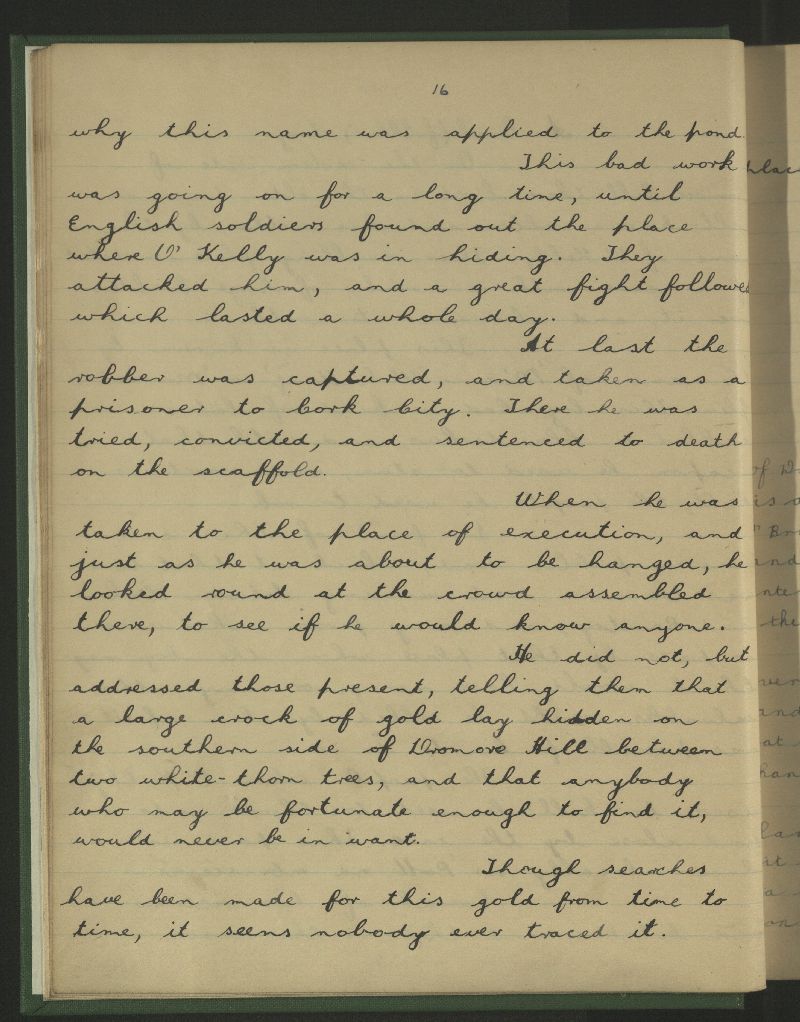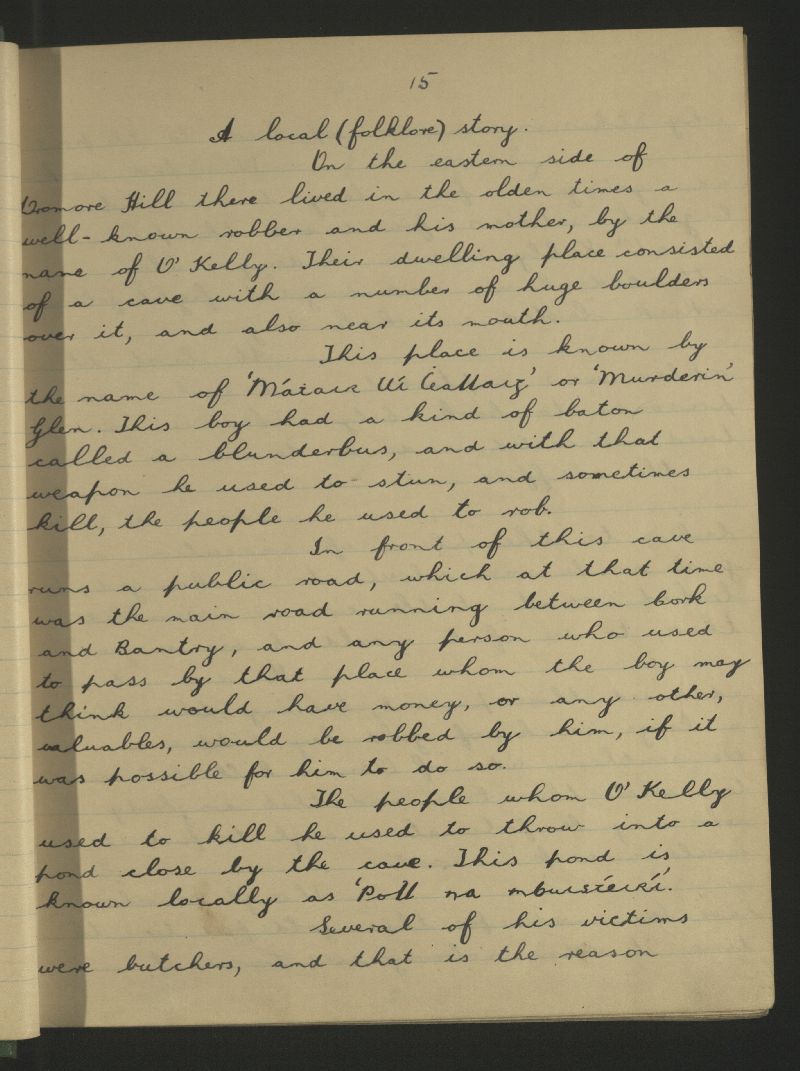The long valleys that run eastwards from Bantry are filled with antiquities – Discovery Map 85 is dotted with red circles of places we want to tramp around. We have been particularly intrigued by the ‘Murdering Glen’, labelled on the map: can you see it?.
Today we got a chance for a thorough exploration of the Murdering Glen, on the invitation of our friend Bridget, who lives there and is a keen explorer herself. After a wonderful lunch supplied mainly from her garden we set out up the road towards the Glen, with Bridget assuring us that the place appeared peaceful enough these days and not to worry.
The Glen is indeed dramatic, with steep sides and an enormous overhanging rock – just the kind of place for a brigand to lurk. In this case the brigand (and his mother) were locals, by the name of O’Kelly, who would lay in wait for travellers and murder them for their gold, before throwing them into the Butcher’s Pool.
In the 1930s schoolchildren in every National School in Ireland were asked to write down the stories they heard at home and these were recorded, in their own writing, by the National Folklore Commission. Here is the outline of the project, as presented on Duchas, the website that now stores that collection:
For the duration of the project, more than 50,000 schoolchildren from 5,000 schools in the 26 counties of the Irish Free State were enlisted to collect folklore in their home districts. This included oral history, topographical information, folktales and legends, riddles and proverbs, games and pastimes, trades and crafts. The children recorded this material from their parents, grandparents, and neighbours. The scheme resulted in the creation of over half a million manuscript pages, generally referred to as ‘Bailiúchán na Scol’ or ‘The Schools’ Collection’.
To my delight, I was able to find the original story in the collection – and here it is, in the handwriting of schoolboy Michael Keohane from Dromore National School. I think you will agree he has done a magnificent job of telling the local legend.
 Before we left the murderous spot Bridget led us up to the mass rock, on a ledge on the side of the valley. It was a block of sparkling quartz, with holes to collect water, into which you can dip your warts in hopes of a cure.
Before we left the murderous spot Bridget led us up to the mass rock, on a ledge on the side of the valley. It was a block of sparkling quartz, with holes to collect water, into which you can dip your warts in hopes of a cure.
We walked then towards the Trawlebane Bridge, where Robert and I had joined the walk two years ago to honour and remember Chief O’Neil. Robert’s post, The Chief, will take you back to that day and show you the spot where, before we started the walk, participants decided to put on an impromptu display of Crossroads Dancing, just as local people would have done on a fine summer evening in the old days.
There was more, much more to see, just in the immediate neighbourhood. We spent time in a Cillín first, in the middle of a field, with a magnificent blackthorn tree to mark the lonely spot where unbaptised children were traditionally buried. Read more about this practice in my post Unknown Souls.
 A little five-stone circle was next – a classic of its kind, with four stones set on edge and a recumbent stone marking the axial alignment. (See more examples of them in my post Family-Friendly Archaeology). Besides three sites in nearby Kerry, these small stone circles are only found in Cork. They mirror exactly the larger multiple-stone circles, just with fewer stones – an efficient variation requiring fewer resources to erect but accomplishing the same outcomes.
A little five-stone circle was next – a classic of its kind, with four stones set on edge and a recumbent stone marking the axial alignment. (See more examples of them in my post Family-Friendly Archaeology). Besides three sites in nearby Kerry, these small stone circles are only found in Cork. They mirror exactly the larger multiple-stone circles, just with fewer stones – an efficient variation requiring fewer resources to erect but accomplishing the same outcomes.
Unfortunately, this five-stone circle has been filled with field debris, creating the appearance of a mound
We also passed numerous ringforts and several standing stones. Looming over us as we walked was Dromore hill, on top of which was erected, in the Marian Year of 1954, an enormous cross, now rather improbably lit up at night. The cross is clearly visible from the stone circle and the standing stones, presenting opportunities to ponder on the juxtaposition of what is considered sacred in its own day, and what communities will expend precious resources to erect at different times over millennia.
 On our trip to Sligo recently Robert and I were sensitised to the phenomenon of monuments seemingly echoing or imitating the topography behind them – see his post Discovering Carrowmore for more about this. I was struck by one of the standing stones – the top did seem to echo the hill behind it. Coincidence?
On our trip to Sligo recently Robert and I were sensitised to the phenomenon of monuments seemingly echoing or imitating the topography behind them – see his post Discovering Carrowmore for more about this. I was struck by one of the standing stones – the top did seem to echo the hill behind it. Coincidence?
October in West Cork can feature some of the best weather and walking conditions of the year. Today did not disappoint, with blue skies and crisp air.
Thank you, Bridget, and our other exploring companions Amanda and Peter, for a marvellous day of Murder, Mythology and Megaliths.













What a fine cursive hand that schoolboy/girl had! A kind of simplified “copper plate” except for the capitals, many of which seem to be “echt copper plate “. Those elaborate D’s and H’s were always difficult to do convincingly, as I can remember from my boyhood – I gave up on them – and the schoolboy/girl finds them tricky too. My (Irish) mother always used to praise the high standards of the National Schools in Ireland; she would have been a contemporary of the young writer.
LikeLike
They were mastered through long hours of practice in the copy books. I remember writing over and over ‘Kind hearts are more than coronets’.
LikeLike
Interesting tale. The Folklore Collection is a treasure throve of information on local lore.
Just one point I would like to make and that applies to minor place-names, these names are in the vast majority in this part of the country in the Irish language form and are often nuanced in their interpretation. It is vital that from a cultural heritage perspective to use the original Irish version and not a direct translation. Many Irish names can be interpreted differently and often have hidden meanings which are lost when given an English form. By giving the English version to the general public the original form is often dispensed with and that nuance is lost forever over time.
LikeLike
Thank you, Jerome and I’m glad you enjoyed the post. In principle I agree with your point, and I would probably be stricter about this if our readership was Irish-speaking or even Irish. While I know we have many Irish readers, we also have some for whom this would create difficulties. However, I am wondering if your comment is a general one, or if there was a specific instance where you felt that the form of the name I used created a problem? As a general rule, we try to stick with the form as it presented on the OS maps. (Interestingly, of corse, it is often different on road signs and in the used vernacular.)
LikeLike
Hot from the field- you worked very hard! What a great account of a wonderful afternoon, packed full of interesting stuff, gorgeous weather and great company. I love the account from the Michael Keohane, the Schools’ Collection is such a treasure trove of information and you don’t see the word blunderbuss very often these days!
LikeLike
No, you don’t, especially when it describes a ‘baton.’
LikeLike
Great post, lovely weather, nice pictures. Thanks! There is a bit about the Murdering Glen in Windele’s History of Cork from the late 1830s – it’s on Google Books if you’re interested.
LikeLike
Thank you! I found it and have downloaded the book, also available on Cork Co Council site. Looks like another treasure trove!
LikeLike
Hi Finola. I looked for Windele’s work on the Cork County Council website but did not see it anywhere. Would you be able to tell me where exactly it is. Many thanks Jerome.
LikeLike
Hi Jerome, I found it at http://www.corkpastandpresent.ie/history/windelescork/
LikeLike
Go raibh mile maith agat Finola.
LikeLike
Ná habair é
LikeLike